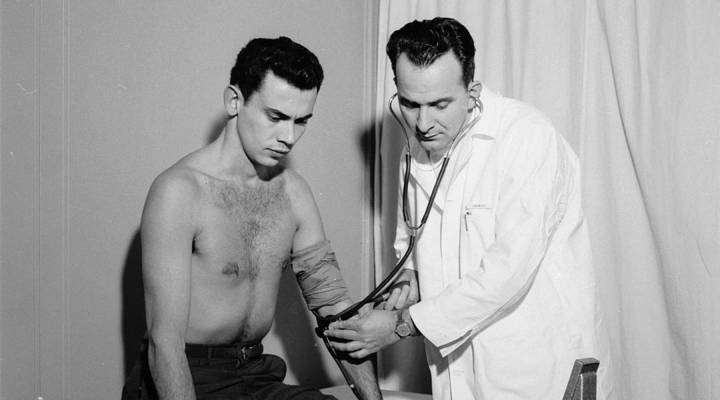
How did we end up with health insurance being tied to our jobs?
How did we end up with health insurance being tied to our jobs?

It’s getting little attention right now as the GOP-led Congress struggles to pass a bill to repeal and replace Obamacare, but our employer-sponsored health insurance system is the elephant in the room.
In Washington, the debate largely centers on the level of assistance the federal government should provide to the millions of people under age 65 who don’t get insurance at work. Most Western nations offer universal health coverage.
More than any other country, the U.S. relies on employers to provide insurance, with more than 175 million people gaining coverage through work. For more than 70 years, the nation has struggled to figure out how to provide care to people outside that system.
So how did we end up with such an unusual system that leaves so many people on the outside looking in?
The story starts by the fire. It’s October 1942. In his fireside chat, President Franklin Delano Roosevelt described a growing war.
“With every passing week, the war increases in scope and intensity,” he said. “That is true in Europe, in Africa, in Asia and on all the seas.”
| Health care takes on the fight against trafficking |
| This cancer patient is devoting his life to making drugs more affordable |
At home there was also a battle — for workers.
“You’re coming out of the Depression and all of a sudden hiring ramps up,” said Sherry Glied, professor of public service at New York University. So many men are abroad that businesses are desperate for employees that “wages start to climb and prices start to climb. We start to see major inflation happening in the U.S. economy,” Glied said.
In that October chat, President Roosevelt argued that economic sacrifices at home were needed as much as any new tank.
“We shall be compelled to stop workers from moving from one war job to another as a matter of personal preference; to stop employers from stealing labor from each other,” Roosevelt said.
That year, the National War Labor Board forbade employers from raising their workers’ salaries — a wage cap. If our employer-sponsored insurance system has an origin story, it is this.
Beyond the wage cap, the labor board also ruled health insurance was exempt from the cap, so employers began to dangle health insurance as a benefit to attract the best and brightest.
The cherry on top: The IRS decided employer contributions to health insurance premiums were tax free, which meant workers paid less out of their pocket.
This all happened as a medical miracle unfolded — the arrival of penicillin.
“Before the 1930s, you probably didn’t want to be treated if you were a rational human being,” said NYU’s Glied. “This is the moment where medical care really takes off.”
| Crowdfunding for your life |
| Will the Senate’s new GOP health care bill ultimately lead to better services? |
By 1952, just a decade after Roosevelt’s fireside chat, the economy hummed along.
People wanted new Fords, the best medical care and shiny everything. Private employer-sponsored health insurance exploded.
“How many people have this important private health insurance? Only 8 million people in 1939. But in 1952, 92 million,” Oveta Culp Hobby said in a speech in the mid-1950s. Culp Hobby was President Dwight Eisenhower’s health secretary and just the second women to hold a presidential cabinet post.
She pitched Eisenhower’s plan to provide national insurance to the 63 million uninsured Americans who lacked coverage either because they were too old, worked for employers who didn’t provide insurance or were out of work.
It was the third pass at getting some kind of national health plan in place since the end of the war and join most other Western nations in providing coverage for all.
Melissa Thomasson, a Miami University professor of economics, said each time there’s a push to expand coverage, doctors — through their lobbying group, the American Medical Association — launch scorched-earth campaigns.
“Doctors have always worried that it would limit their ability to charge patients what they wanted,” she said. Physicians “say if health insurance is nationalized, it’s likely that government won’t stop there. They’ll start nationalizing other industries, too. So they use the fear factor to kill it,” Thomasson said.
That largely ended any serious attempt at national insurance. The employer-sponsored insurance became king.
Over the decades since, presidents have taken cracks at getting coverage to people outside the employer system — most notably Lyndon Johnson with Medicare and Medicaid, and Barack Obama with Obamacare.
And today it’s President Donald Trump’s turn to try to answer a question that still lacks a sustainable answer — how to care for all those people who fall outside of the employer-sponsored health insurance system.
There’s a lot happening in the world. Through it all, Marketplace is here for you.
You rely on Marketplace to break down the world’s events and tell you how it affects you in a fact-based, approachable way. We rely on your financial support to keep making that possible.
Your donation today powers the independent journalism that you rely on. For just $5/month, you can help sustain Marketplace so we can keep reporting on the things that matter to you.












